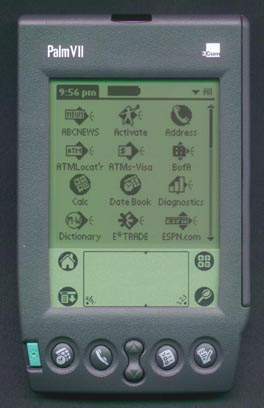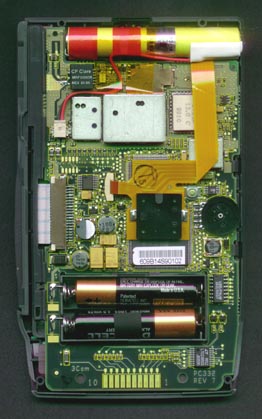

Current Cover
|
|
|
|
Palm VIILike its predecessors, the Palm VII doesn't do all that a desktop does, but it just might do enough.by Shawn BarnettWith the flip of an antenna, Palm VII users are able to access data wirelessly wherever they are, getting just the data they need, just when they need it. It's been months in development and testing, and the folks at 3Com apparently think it's time to get the Palm VII out on the street.
May 24, 1999, the Palm VII began limited sale in the New York Tri-State area. There have been several hundreds of beta units in use across the nation for a few months, and an even more limited number since the product's announcement in November, 1998. The Palm VII, cosmetically, is a Palm III with an extended forehead and a flip-up antenna, hinged on the top right. Around the office we've been lovingly calling it the Franken-Palm, because of its high, square forehead. It has 2MB of RAM, is powered by two AAA batteries, runs on the same Motorola DragonBall processor as its predecessors, and HotSyncs like any other Palm device.
What sets it apart is what's behind that square forehead. If you open the unit up, there's a long, red and yellow, cylindrical battery running along the top, which is recharged daily by the two AAA batteries. This battery runs the Palm VII's send-and-receive radio. Surprisingly, this charging still allows the main AAA batteries to run for a week or more, even under extensive use. Clearly, this radio is quite an engineering achievement. The Palm VII innards do not allow for any memory upgrades, as that area is taken by the various radio components that make the VII what it is.
More than one of us here at the Pen Computing Editorial Office has found the Palm VII very useful for getting everything from sports scores, to directions in distant cities, to email, across the nation. Our Editor-in-Chief has used it to allay stress as he checked basketball scores periodically with the ESPN.com application (because he couldn't stand to watch the game on TV, but somehow tracking the scores electronically made it easier).
Interestingly, the Palm VII has been controversial from the day it was announced. Many attempts at creating a wireless digital data device have failed in the past, and few seem to expect the Palm VII with its Palm.net "Web Clipping" service to succeed. Many of the large magazines have weighed in, and the consensus seems to be that it will fail, much like the Newton did. The Apple Newton, despite its obvious elegance and utility, was viewed as undesirable because of early reports of its poor handwriting recognition. Even when it overcame those problems, the product's reputation was indelibly ruined. I do not believe this will happen to the Palm VII, but only time can tell.
So what are critics seeing as the Palm VII's downfall? Clipped content and high pricing. Let's give those two things a look.
The Palm VII, as I've noted, has a radio that transmits in short bursts to achieve its incredible efficiency. As launched, it will work on BellSouth's nationwide pager network. It can, however, be made to work with many other services, allowing it to be used in many types of applications. For example, a company could easily connect their workers to company intranet data either locally or nationwide. These units would likely have to be made specially for a given network type, but it is clear that there are many tantalizing possibilites. Because wireless transmission time is costly, Palm decided to create a way to clip the content of web pages down to just the necessary data, much as products like AvantGo do when downloading HTML via a computer to the other Palm units. To achieve this, Palm created Palm.net. Companies desiring to offer their services to Palm VII customers create clipped content that can be easily read on the platform.
So that only the data needed is transmitted, the Palm VII requires that special Query Applications be preloaded from the desktop. These help direct the user with data entry fields and provide limited graphics in the application, so graphics need not travel over the airwaves. The Weather Channel Query App, for instance, already has the various icons for everything from sunny days to rainy days, and all that needs to be downloaded is the tag that specifies which icon to display and the temperature. That's not a whole lot of data, but it gets a whole lot of information across, and it's instantly accessible.
The criticism is that most users will want more than just clipped versions of the informative web sites they love, they'll want the real deal. The truth is, many users already have this available with wireless modems on their notebooks and even on Palms and other PDAs, but it's very expensive, pretty slow, and sucks up battery life. For these reasons, it just hasn't taken off.
Palm decided to see if wireless data could be handled another way, much like they did with desktop data on the early Pilot. The Pilot didn't do everything a desktop did, but it did enough, holding addresses, notes, and appointments; and that has made it what it is today: a personal computer platform doing more than its creators imagined. Its trustworthiness with a little has made users and corporations alike gradually trust it with much more. 3Com is clearly hoping the Palm VII will continue that trend.
As for pricing, here is where there may indeed be a problem. It is not an insurmountable problem, but there is a danger that it could be the thing the media latches onto that destroys the Palm VII's reputation. Indeed, on the first demo units we received, what was considered minor usage took one of us well above the 50K allowed with the US$9.95 standard pricing plan, and the bill went into the hundreds of dollars in just one week. This could discourage users, much like early AOL users who chatted online for hours and got disabling multi-hundred dollar bills as a reward (then again, AOL is still going strong).
Still, another of us has used his Palm VII primarily for email and the occasional weather check, and he's hardly put a dent in his usage allocation with the Standard Plan. Naturally, different queries will use more data, such as downloading multiple news stories, or having everyone CC your Palm.net address to make sure they get email to you (the Palm actually gives you only a small amount of the email, then asks you whether you want the rest, telling you how many bytes it will use up).
Whether it will cost too much remains to be seen. Most likely the first few months will be more costly, as users show off their new toy to friends and colleagues.
But all this is just speculation. Time will tell how the Palm community takes to the newest Palm. What does this thing actually allow a user to do, and who is it for?
The Palm VII is primarily a tool for traveling business people, allowing them to access numerous practical references, saving them from having to carry many reference books, CDs, or even a notebook computer. Instead of gathering up all their essential trip data the night before, which could easily be old by morning, business travelers can say, "I'll just grab my Seven." And they'll have it all.
Users can track stocks, schedule or reschedule flights, track UPS packages, find restaurants and hotels with accompanying Fodor's reviews, find phone numbers with Yahoo's people finder, get their local weather, find a movie location and time, get directions from anywhere to anywhere with MapQuest, read the news from ABC, USA Today, or The Wall Street Journal, find an ATM, look up a word in the dictionary, and new applications will be coming online as companies and programmers think of them. They also get a Palm.net email address. They cannot access their existing ISP, unfortunately, but a smart user could figure out a way to have email forwarded to their Palm VII.
Something I'd like to see: I would like the Palm VII to either wake up and check my email without my flipping the antenna up (transmission is disabled on the Palm VII unless the antenna is up, to safeguard against accidental transmission or reception), or I would like it to act as a pager, notifying me immediately when a message is received or, say, when a stock takes a dive. As it is now, users only get their email if they check for it.
Out of the box, users will need to put the included batteries in the Palm VII and let them charge the radio transmitter battery for 70 minutes before "activating" the unit. Once the transmitter battery is charged, the user just flips up the antenna--which turns the Palm VII on and opens the Palm.Net category--clicks on the Activate icon, and follows the onscreen instructions. The process includes entering a credit card number to pay for the activation. The network uses Certicom's elliptical curve encryption technology, so this is considered extremely safe. Within a very short time, users will be able to get online with their Palm VII's without any elaborate hardware or software setup.
Software installation is similar to previous units, the only difference being the installation of the first additional query applications. A few are preloaded, and users pick which additional applications they want. A shortcoming of the software is that data downloaded wirelessly to the Palm VII has no companion on the Palm Desktop for synchronization. It is an unfortunate omission. Considering that many users will be paying additional money to get information wirelessly, why should they waste time finding it again on their desktop browsers? And what if they can't? The cut and paste feature of the Palm is woefully inadequate for moving large blocks of text. Some programmer will come along and fix that if we're lucky.
Which brings up a point that few are considering when they choose to predict the doom of the Palm VII: the success of the Palm computer is due in no small part to the many programmers and hardware designers who've successfully extended the usefulness of these small wonders in unbelievable ways in just four short years. What makes the nay-sayers think these guys are going to leave the Palm VII alone?
The Palm VII has a list price of US$599. That may seem like a lot at first, but if you consider the cost of an average PDA, US$300 - 900, and add a US$300 wireless modem, the price of a Palm VII doesn't seem so bad. Compare that to a US$1,000 - 2,500 notebook computer with a $300 wireless modem, and you begin to see the value of the Palm VII. Add the facts that the other solutions are battery hogs, and so big and heavy that you're not likely to have them with you all the time, and the shirt-pocketable US$599 Palm VII is just about right.
Pricing plans, chosen at activation, are US$9.99 for the Standard Plan, which gives you 50K of data per month, and US$24.99 for the Extended Plan, giving a roomier 150K per month.
So the day has finally come, and the Palm VII is out there. The nay-sayers have made their preparations for future "I-told-you-so's" if the Palm VII fails. Allow me to prepare for mine: I think it's going to work.
Link to 3COM Palm Computing Division: www.palm.com For more info about Palm.net servce, coverage, etc.: www.palm.net |

